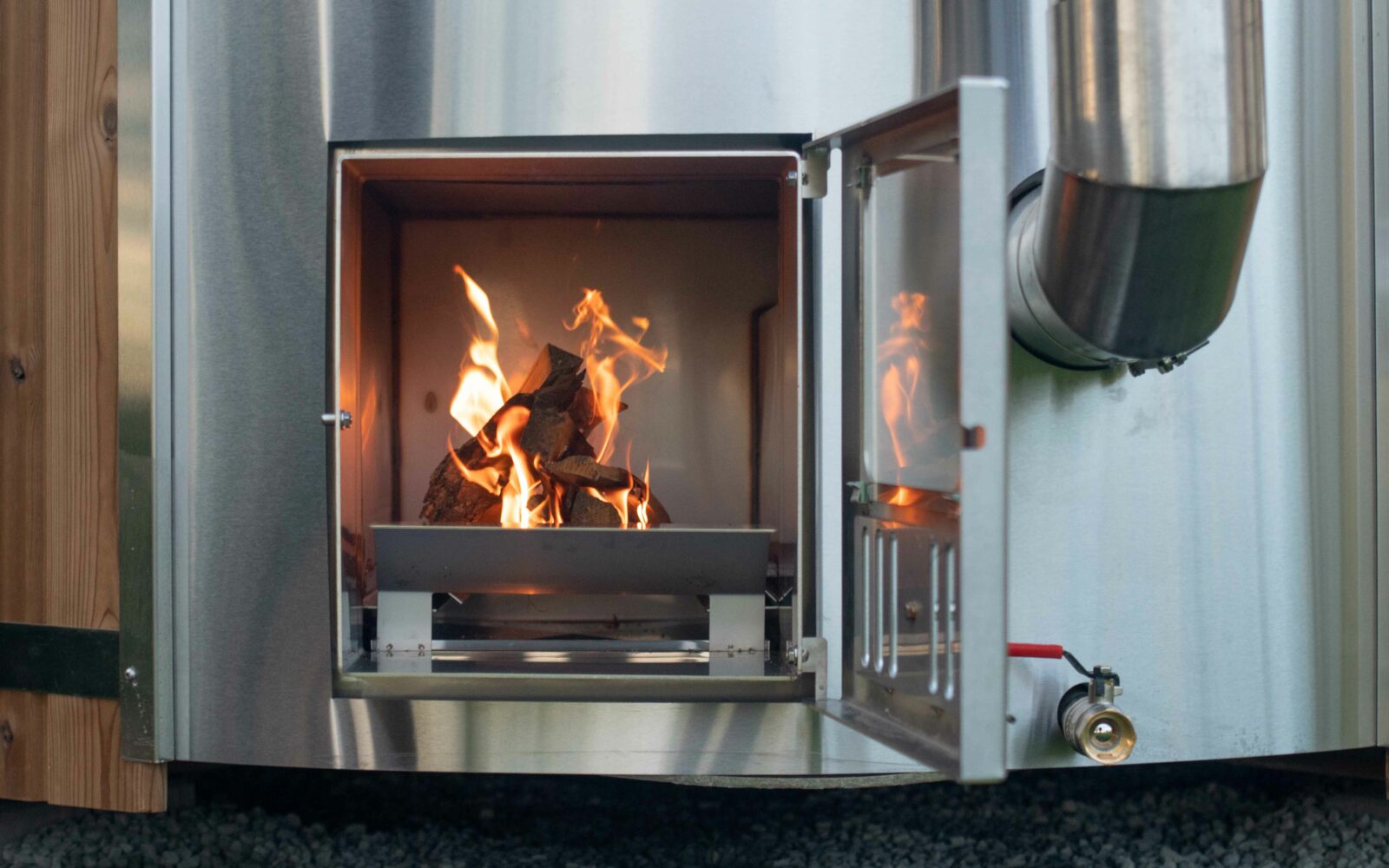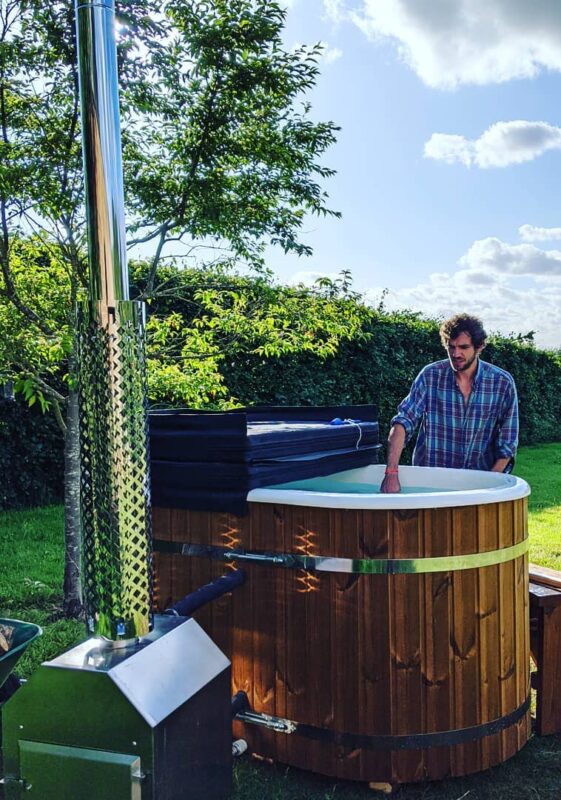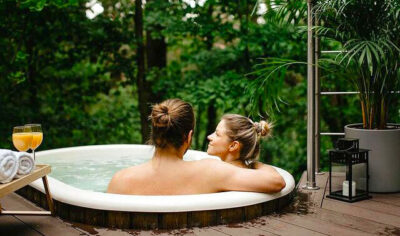Wood Fired Hot Tubs – Heater Options Explained

When choosing a wood-fired hot tub the options available can be daunting, especially with more expensive elements such as the wood stove.
This post will take a look at the types of heater available for wood-fired hot tubs and explain their pros and cons so you can make an informed decision, ensuring that your wood-fired hot tub is nothing less than a delight to live with every time you light the fire.
Heater Types – What’s Out There?
Often confused with the tub type, the wood-fired stove that warms your tub is a customisable feature. Considering that you’ll use the stove every time you hop in the tub, this gives you the freedom to choose a heater that suits your budget, lifestyle, and the final look of your wood-fired hot tub.
Wood-fired stoves for hot tubs can be categorised into 3 types:
- External Integrated
- External
- Internal
External Integrated Heaters
External integrated stoves are synonymous with luxury wood-fired hot tubs.
Nestled into the exterior of the tub itself, from the outside an external integrated stove presents only a sleek surround and a window to the heart to your tub. The stove is accessed through an external door to the firebox, for loading and lighting the fire, as well as emptying the ash periodically.
These heaters are connected to the bathing water via inlet and outlet ports within the hot tub liner and tend to be the most attractive option, with all of the “workings” concealed within the tub body. Heat is conveyed through natural gravitation currents, meaning no pumps or electronics are required.
External integrated heaters are not available with all types of wood-fired hot tub. They can be fitted to fibreglass lined tubs only, due to the strength needed in the liner for moulding around the stove within the hot tub body.
External Heaters
As the name suggestions an external heater sits outside of the hot tub itself, positioned alongside the tub. The heater is connected to the bathing water via two hoses for inlet and outlet, and the heat is transferred by gravitation of convection currents.
External heaters can be fitted to any type of wood-fired hot tub, and tend to be the easiest to light and maintain, thanks to their ease of access.
While this ease makes them a favoured option for many, it should be noted that more space is required to position the stove alongside the hot tub, and safety provisions should be made to ensure that users (especially children) are protected from the hot surfaces.
These heaters also allow more room within the hot tub itself because all of the apparatus is apart, meaning more people can fit into a tub of a given size.
External heaters are the only option available for Ofuro hot tubs, due to limited space inside the tub on account of their shape.
Internal Heaters
Internal heaters are installed within the bathing area of a wood-fired hot tub, separated by a wooden fence. They are loaded from above, and tend to be the most budget-friendly heater option.
By integrating the internal heater into the hot tub body, space can be saved which makes internal heaters a perfect choice for locations where access around the hot tub is at a premium.
As internal heaters sit within the bathing water, their operation is very simple and they are highly efficient, with all heat from the stove body being transferred to the water itself.
Because an internal heater sits within the wood-fired hot tub itself, they reduce the capacity of the hot tub by 2 people – something which should be considered when making your selection. This means that a 4-6 person hot tub would hold 4 people when fitted with an internal heater, and so on.
A Note On Chimneys
All wood-fired stoves need a chimney to vent the smoke from the fire heating your tub. The chimney is connected to the stove itself, and vents vertically. When choosing the most suitable heaster for your wood-fired hot tub you should consider the chimney with a view to safety, as they will get hot when the stove has been in use. It’s important to ensure that users are protected from burns arising from contact with the flue; chimney guards are an optional accessory to greatly reduce the chance of injury from contact with the hot metal.
Steel Choices: Should You Upgrade?
This is where heater selection can become very daunting… But don’t worry, we’ll give a short explanation as to why this matters to you (or why it may not).
Different steel grades offer different properties, and the grade required will depend on how you plan on using your tub.
All of our standard stoves are manufactured from 430 grade stainless steel. This is a higher grade than many of our competitors use, however it boasts strong anti-corrosive properties and will reliably last a long time under the conditions present in the firebox.
Royal Tubs do not offer aluminium stoves. While these stoves are cheaper to produce and resistant to chemical corrosion, they tend to degrade much faster through exposure to the high temperatures present within a wood-burning stove and hence we don’t consider them durable enough for the application.
We offer heater upgrades to 304 and 316-grade stainless steel.
304-grade stainless steel includes nickel in the steel alloy. This greatly improves the metal’s corrosion resistance, although the cost of the material increases because of this. The outcome is a longer lasting stove, at the cost of a higher purchase price.
316-grade stainless steel has an increased nickel content compared with 304, and also includes molybdenum in the alloy. This gives the steel superior corrosion resistance, especially from acids and chlorides.
In short?
430 grade is a resistant, high quality stainless steel grade used as standard in our heaters.
304 -grade has superior corrosion resistance in comparison to 430.
316-grade stainless steel is more resistant than 304 and 430-grade, especially against corrosion from chlorides.
The steel grade is particularly relevant to wood-fired hot tubs where chemicals are going to be used to prolong the period between drain downs and improve the water hygiene.
You may choose to upgrade your heater for added longevity, but this is only a strict requirement where you will use chemicals in the water of your wood-fired hot tub.
Using Chemicals in the Water
In short, our standard 430 grade steel is not suitable for the use of chemicals in the water. 304 and 316-grade stainless steel offer corrosion resistance, which allows for the use of chemicals, with 316 grade being the longest lasting under these conditions. If you plan to use chemicals in the water, the heater must be upgraded to accommodate this.
What To Consider When Choosing Your Heater Type
Now you know the difference between the heater types available for a wood-fired hot tub, which is the best for your tub?
These factors will determine the best choice for you.
Location & Accessibility
You’ve no doubt already got your eye on a spot to sit your new wood-fired hot tub, and its surroundings will play a part in choosing the best type of stove.
- If your wood-fired tub is going to sit into an alcove, recess or corner, access in and out of the tub is going to be restricted to one or two sides of the tub. With space around the tub at a premium, an external heater would take up valuable room and the reduced clearance would increase the chance of injury from contact with the stove. In this case, an internal or external integrated heater would be the better option.
- If your tub is going to sit in an open area, with free access around it an external integrated or external heater is often favoured, to free up space within the hot tub itself and make cleaning and lighting easier.
- In a rural garden, a wood-fired tub often sits into its surroundings seamlessly. Choosing an internal heater means that the exterior timber facade of the hot tub is unfettered giving a natural appearance and allowing the tub to blend into the landscape.
- Where a wood-fired hot tub is installed for use by paying guests, such as a holiday let or glamping site, an integrated external heater is usually preferred. Their inset fitting makes the chance of contact injuries very low, and their eye-catching nature and ease of use makes them a delight for guests, often appearing in glowing reviews.
Type of Wood-Fired Hot Tub
As we touched on earlier, not all heaters are suitable for use across all tub types.
Fibreglass wood-fired hot tubs are the only models suitable for use with an external integrated heater. Where an external integrated heater is preferred (often for the aesthetic touch) it is very common for the heater choice to drive the tub-type selection.
External heaters are also commonly used with fibreglass hot tubs, to free up additional space within the bathing area for more guests while maintaining the benefits of the shaped liner for comfort and convenience.
Internal heaters are commonly chosen for use with Traditional wooden hot tubs. Not only is this combination the most budget-friendly of the tub/heater pairings, but having the heater fitted (and hence concealed) within the hot tub body leaves a clean, unfettered finish to the external timber facade. This allows the hot tub to complement a natural setting and adds to the sense of connection between the hot tub and its surrounding landscape.
Both external and internal heaters can be used with poly-lined wood-fired hot tubs. As with traditional wooden tubs, internal heaters tend to be favoured on cost grounds, or to maintain a natural appearance while external heaters are often selected because they’re easy to access for cleaning and lighting.
Stove Access
Often overlooked by customers already immersed in the magical idea of relaxing in their new wood-fired hot tub, access to the stove is required every time you use your tub, and for periodic cleaning of the ashpan.
While internal heaters have many benefits, they tend to be slightly more awkward to clean as everything has to be done from above.
In comparison, external heaters can be positioned freely away from the tub to ensure clear access all around for inspection, and keep the fire door easily accessible for both loading and lighting the fire as well as cleaning the ash when required. In gardens where space is freely available and for customers who want to remove as many obstacles as possible between making the decision to enjoy and actually hopping in, external heaters are a firm favourite.
Although only available for use with fibreglass wood-fired hot tubs, external integrated heaters are a firm favourite. The sight of the roaring flame through the glass adds depth to the tubbing experience and their lighting and use is often compared with a wood-burning stove, adding an element of familiarity for users. As with a standard external heater, access for lighting and cleaning is very easy, with everything carried out from directly in front of the heater.
Summary
Ultimately, heater choice very often comes down to personal preference and the money you’re willing to spend on a wood-fired hot tub.
While considerations such as access and positioning are crucial in making sure your new wood-fired hot tub can be used safely and easily, the most important factor is choosing a heater that’s suitable for your garden and your budget.
With all things being equal, the heater is likely to be the last thing on your mind while you’re nestled back beneath the water enjoying the night sky and good company, but the wrong choice could cast a shadow over an experience that should be nothing less than delightful .



